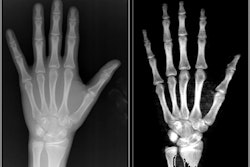
An artificial intelligence (AI) algorithm called DXA-Age yielded valuable insight into a patient's future health risks based on analysis of whole-body dual-energy x-ray absorptiometry (DEXA) scans, according to research presented at the RSNA 2021 meeting in Chicago.
Presenter Vineet Raghu, PhD, and colleagues from the MGH Cardiovascular Imaging Research Center and BWH program for Artificial Intelligence in Medicine have developed DXA-Age, an AI model that yielded biological age estimates from whole-body DEXA exams that enabled risk stratification for future risk of morbidity and mortality.
"DXA-Age may help direct prevention and screening interventions to those at higher risk for incident chronic disease in the future," Raghu said.
Age is a cornerstone of medical decision-making, but equal age doesn't necessarily imply equal health. Factors such as lifestyle and family history of disease can result in biological aging faster than chronological aging, according to Raghu.
A patient's biological age can be measured from physical tests such as gait speed, as well as other assessments such as DNA methylation-based aging clocks and blood biomarkers including leukocyte telomere length, he said.
"Biological age measures have been shown to have robust correlations with chronological age, but the cool thing is that they also have additive predictive value for incident morbidity and mortality beyond chronological age alone," Raghu said.
The research team had previously developed CXR-Age, a deep-learning algorithm that could estimate a patient's biological age on chest x-rays. The group hypothesized, though, that whole-body DEXA scans may provide a window into age-related changes and be able to estimate biological age from muscle/fat composition, bone density, as well as lung and heart health.
As a result, they tested whether a deep-learning model's estimated patient's biological age could be an independent predictor of future disease risk, including all-cause mortality, cardiovascular disease, and cardiometabolic disease beyond known risk factors.
DXA-Age encompasses two separate convolutional neural networks (CNNs); one model analyzes the soft-tissue whole-body DEXA views, while the other assesses the skeletal views. Each algorithm's results are eventually fused together and used to provide an estimated patient's biological age, which can then be compared with the patient's chronological age.
The model was trained and tested using whole-body DEXA scans from 39,530 individuals from the UK Biobank Imaging Enhancement study. Of these subjects, 7,582 were used for training and 31,948 were reserved as an independent testing set. The primary study outcome was incident all-cause mortality and incident morbidity.
The researchers found that DXA-Age had a robust correlation (r = 0.82) with chronological age. It was also associated with prevalent morbidities such as essential hypertension; type 2 diabetes; obstructive chronic bronchitis; atrial fibrillation and flutter; chronic airway obstruction, and alcohol-related disorders, according to the researchers.
What's more, the algorithm was also highly correlated with body composition measures such as visceral and subcutaneous adipose tissue, waist circumference, and body mass index (BMI), as well as measures of biological aging including clonal hematopoiesis and telomere length.
To assess the performance of DXA-Age for predicting incident morbidity and mortality, the researchers first stratified the DXA-Age results into low (< 50th percentile), medium (≥ 50th and < 75th percentile), and high (≥ 75th percentile) age groups based on the quantiles in the development dataset.
They then calculated the hazard ratios for the high-age group relative to the low-age group, adjusted for variables such as chronological age, sex, BMI, smoking status, prevalent hypertension, prevalent type 2 diabetes, waist circumference, total mass, tissue fat percentage, height, weight, and bone mineral density.
| Greater risk of mortality and morbidity from higher DXA-Age result | ||
| Adjusted hazard ratio for high vs. low DXA-Age result | p-value | |
| All-cause mortality | 1.98 | 0.009 |
| Incident diabetes | 2.56 | < 0.001 |
| Incident hypertension | 1.59 | < 0.001 |
| Myocardial infarction/stroke | 1.36 | 0.006 |
"A deep learning-based DXA-Age predicts incident morbidity and mortality beyond chronological age, body composition, bone density, and risk factors," Raghu concluded.




















